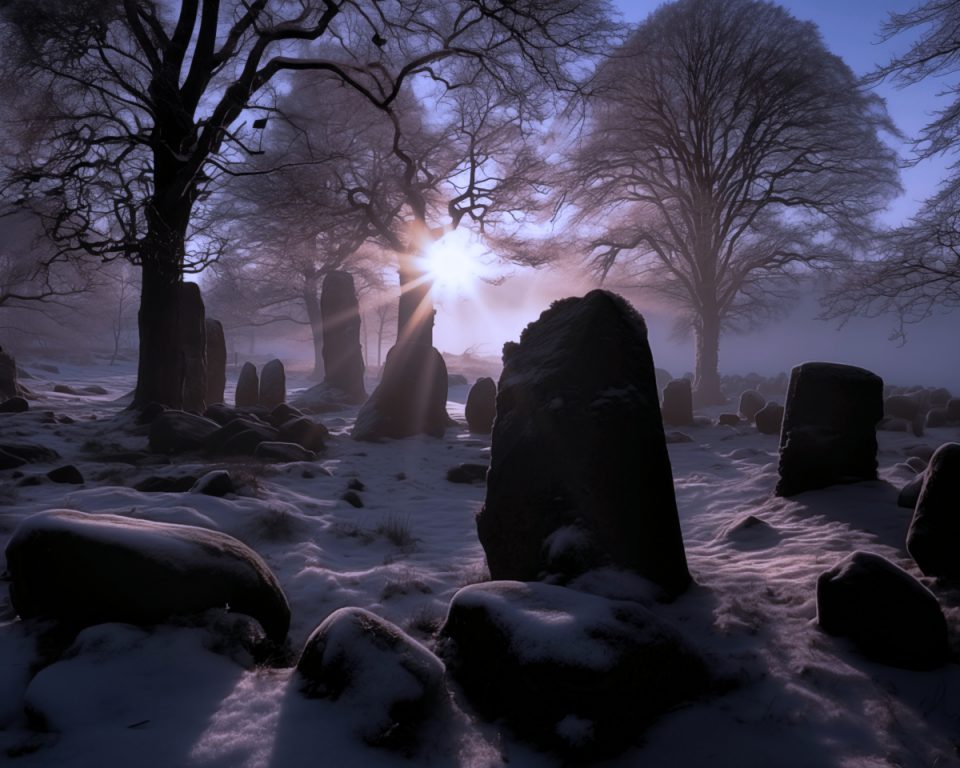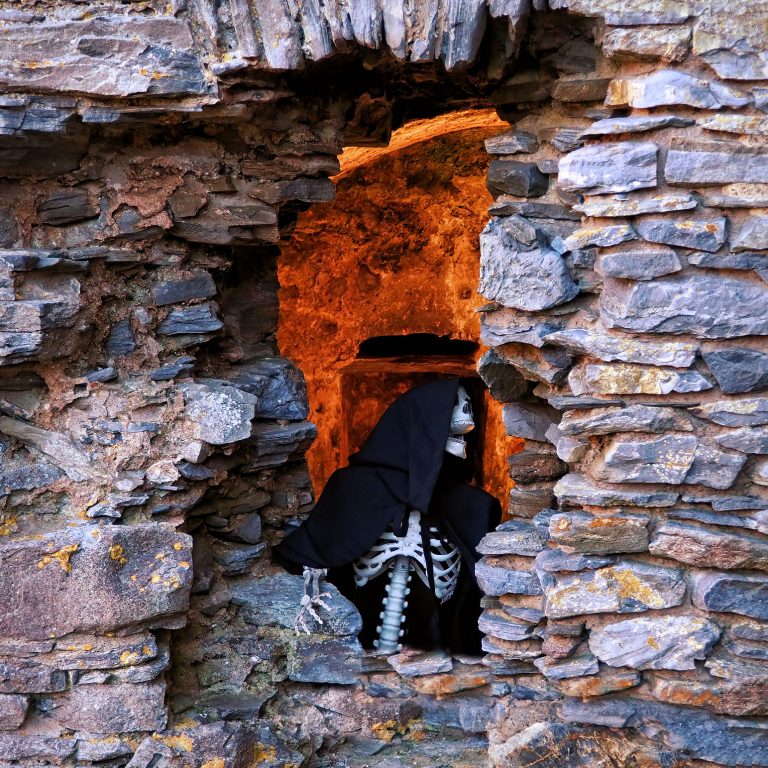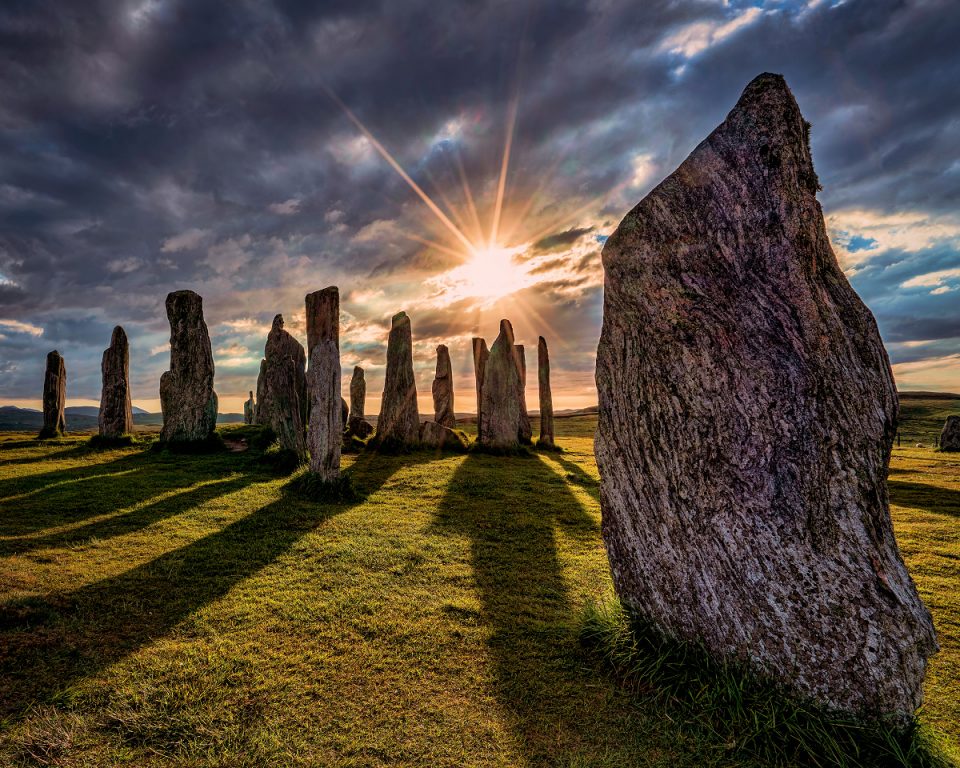In Scotland, Beltane and May Day are almost synonymous. May Day is a Spring holiday celebrated across Europe on May the First. It has ancient origins, some which extend back into the pagan rituals of the Romans. For the Gaelic-speaking people it aligns with Beltane (or Beltainn), celebrated each year on the 30th of April.
Beltane
Beltane was one of the four quarter-day festivals in the Gaelic year, the others being Lughnasadh, Samhain and Imbloc. The passing of the seasons and the turning of the wheel of the year was important to the early inhabitants of Scotland. From Neolithic times the heavens had been watched and the solstices and equinoxes had been celebrated. Many of the major events during the farming year occurred on the quarter days, halfway between equinoxes and solstices. Beltane marked the return of summer. This was an important time in the farming year when the land became fertile and the herds were set out to pasture.
The word Beltane translates as ‘bright fire’ and as such the lighting of the Beltane fire was a central part of the ritual. Household fires were doused before the lighting of the bonfire. The Beltane rituals were used to protect livestock, crops and people and to promote growth and fertility. Fire was used to purify and heal. The fire would have been walked around and jumped and danced over. Farmers would have driven their cattle between the bonfires to cleanse them before putting them out to pasture.
The hearth fires would then be re-kindled as a new ‘neid’ fire. Thus, all the households in the community were connected to one another through the sacred Beltane Fire.
Beltane Bannocks
Beltane was a time of feasting. Traditionally a Beltane bannock was made and eaten on Beltane morning to ensure the health of your crops and flocks. A simple folk magic ritual was performed. The bannock was divided into nine knobs. Each knob was dedicated to something which they felt preserved their livestock. Facing a fire, the person leading the ritual would ask for the safety of their livestock or for a wild animal to spare their herd. At the same time, they would toss a piece of the bannock over their shoulder.
In another tradition, the bannock would be broken into pieces. One of the resulting pieces would be marked with a piece of char from the fire. The blackened piece was known as the Cailleach Beltuinn or the Bealtainn Carline. The pieces were drawn from a bonnet and the person drawing the marked piece was considered to be the ‘sacrifice’ for the night. This was all done in jest, with the sacrifice being forced towards the fire, only to be ‘saved’ or they were made to jump over the fire three times. Afterwards, they were considered to be dead for the night and spoken of as if they had crossed over to the otherworld. Perhaps this is a primal memory of a time when sacrifices really did occur.
Visiting Wells
Beltane also saw many people visiting wells. In Perthshire, there is a place known as Tullybelton. Originally it would have been Tulaich Bhealltainn or the Hill of Beltane or Tullie-Beltane. This is the site of a stone circle with eight upright stones known as the Druid’s Temple. A well is associated with this. Jamieson says in his ‘Scottish Dictionary’:
“On Beltane morning, superstitious people go to this well and drink of it, then they make a procession round it, as I am informed, nine times; after this, they, in like manner, go round the temple.”
There was a similar custom at Welltrees Meadow in Sanquhar Parish. There was once a spring which flowed through the area called St Bride’s Well. Apparently, there was a custom where the maidens of Sanquhar would gather at the well at Beltane, and each would bring an offering of nine stones.
Beltane: The hinge of the year
Beltane was one of the hinges of the Gaelic year, the other being Samhain. It seems that the months from Beltane to Samhain were governed over by Brìde, while the months between Samhain and Beltane were governed over by the Cailleach or the Carlin.
Saint Brìde or Briget has become a popular Saint in the Celtic countries. However, it seems that she is probably based on a pre-Christian Irish Goddess. The early Christian church often incorporated aspects of earlier pagan belief into their faith, in the hope that it would make their belief system more palatable to the people they were trying to convert.
The fight between Brìde and the Cailleach has been used to explain the passing of the seasons. Perhaps this is best told in the Tale of Bride and Angus. This is an ancient tale which has been pieced together from tiny fragments of folklore.
Brìde and Angus
In the dawning of time, the earth was not as it is now. Once it was a vast ocean with no land, save for a huge mill wheel which lay upon the seabed. Alas, the stone was so enormous it took nine giant sisters to turn the wheel. As they did, brown-red clay came churning out of the mill and each of the sisters filled the creel, which was fixed upon her back. Then the nine women set off in nine different directions and began the process of birthing the land.
Beira or the Cailleach Goddess of Winter
One of the sisters, Beira, was a hag who headed to the North, and there became the queen of all the goddesses. Beira was given many names. To the Gaels, she was the Cailleach or the Cailleach Bheur. In the east, she was known as the Carlin or the Gyre-Carlin. Amongst the fisherfolk, she was given the oxymoronic name Gentle Annie, bringer of the winter gales and storms. As she walked, great clods of earth began to spill from her creel, forming the mountains of Scotland. She wielded her mighty hammer, thumping the earth to create valleys and glens. And at length, when she had finished her work, she gazed around the land that she had made, and she chose the highest mountain in Scotland, Ben Nevis, for her home.
She was the Goddess of Winter for it was the most powerful of all seasons. No other season could bring so much disruption to the early peoples of Scotland. This was the time when hunger gnawed at their bellies and the cold sunk deep into their bones.
Beira had only one eye, but it was as keen as an eagle’s and as swift as the ocean mackerel. Her teeth were as red as rust, and her hair was as white as hard frost upon aspen. Her skin was dull dark blue and wrinkled with age for the hag was older than the hills.
Beira enslaves Brìde
Beira was a jealous and capricious Goddess. Every year she made a futile attempt to stop the oncoming spring by hammering down any green shoots and knocking new buds off the trees with her sharp switch.
Beira had many slaves, and one winter she captured the fair maiden called Brìde. She imprisoned Bride in the depths of Ben Nevis. She was constantly scolding Bride, finding fault with her and forcing her to do the most menial and difficult tasks. One day she gave Brìde a dun-coloured fleece and ordered her to wash it in a running stream until it turned pure white. Brìde took the fleece and washed it in the waterfall which cascaded down from the mountain, but, alas, it was all in vain. The fleece would not turn white.
Day after day she laboured and shed tears more numerous than the stars in the night sky. One morning an old grey-bearded man came upon her and found her weeping. ‘Why do you weep so, my child?’
‘Queen Beira has commanded me to make this brown fleece white, but it cannot be done. Who are you?’ she asked.
‘My name is Father Winter. Give me the fleece and I will make it white for you.’
Father Winter took the fleece and he shook it three times; when he handed it back to her it was as white as snow. Then he gave Bride a little bunch of snowdrops and he said, ‘Show these to your mistress and tell her that the green shoots have sprouted beneath the white snow.’
The Coming of Angus Og
With a spring in her step, Bride returned to the mountain castle of Beira and laid the clean fleece at the queen’s feet. But the hag queen scarcely looked at it, for her eyes were fixed sharply upon the snowdrops.
‘Where did you find these flowers?’ she asked angrily.
Brìde told the Cailleach about the old man in the forest.
‘Evil are the tidings you bring me, child! Begone from my sight!’
Beira jumped upon her grey steed and rode off to the North, the South, the East and the West, hammering the earth, and blowing the shoots with her frosty breath to keep the spring at bay.
Meanwhile, on the Green Isle of Summer, which drifted on the silver-blue tides off the West Coast of Scotland, Angus Og, God of Summer, dreamt of a beautiful maiden who was weeping. Upon awakening, he told his father about his dream.
His father replied, ‘The fair princess you have dreamt of is Brìde. And in the days when you are King of Summer, she will be your queen. She is weeping for she has been held captive by the Queen of Winter.’
‘Then I must go forth at once to search for her,’ said Angus Og.
The King said, ‘Ah but now is the wolf month (February- the month of Imbloc) and uncertain is the temper of the wolf. Wait here for a while until the grass begins to grow and the seas are calm.’
‘But I cannot wait. I must go now!’
Angus Pursues his Bride
And so he rode to the ocean, and there he waved his wand three times. He borrowed three days from the month of August, giving them to the month of February. At once the sea was calm and the sun shone through the grey clouds. Angus mounted his white steed sailed eastward across the sea. That night Bride saw him in a dream and her heart whispered that he longed to set her free. When she awoke, she discovered she was shedding tears of joy, and where her tears fell little violets as blue as her eyes sprung up. Angus rode across the snow-covered Beinns of Scotland. At last, he arrived Ben Nevis and freed the beautiful maiden from the fortress. As Brìde stepped outside, the snow melted, and little spring flowers sprung up.
The Queen of the Sìth or the Fairies led Angus and Bride into the Forest. As she greeted them, she waved her wand and transformed Bride’s clothing from rags to a white and silver robe. The linty (linnet) was the first bird in the forest to hail Bride, and the Fairy Queen proclaimed from henceforth, the linty would be known as the bird of Bride. Meanwhile, down on the shore, the oystercatcher shrieked with joy and the Fairy Queen named the oystercatcher the page of Bride.
Marriage of Angus and Bride
Thus the Fairy Queen wed Angus and Bride. As they walked forth from their wedding, they came to a river which was covered in ice. Bride dipped her fingers in the water and the ice melted away as the Hag of Ice shrieked and fled.
“Spring has come!” the herdsmen cried as they drove their cattle and sheep to the moors.
Beira could hear the singing of the birds, and she set off in a rage to wage war against Angus and Bride. She rode on her grey steed, kicking up dark grey clouds at her heels. But Angus and Bride had already left the land of Scotland for the Green Isle of Summer where they were proclaimed King and Queen of Summer.
The battle between Beira and Angus
The battle between Beira and Angus waged on for many days and many weeks. Beira froze the earth and send winds at the end of March to prolong the winter. Finally, Beira was so weary that she threw her hammer underneath a holly bush and she got in a little craft and rowed out to the Isle of Summer. There she sipped from the well of youth and fell fast asleep.
The story of Brìde explains the changing seasons in Scotland. Brìde is the Goddess of Spring and Beira is the Goddess of Winter. And the two are locked in an eternal war. If the tales are true, then Beira was once herself very young and beautiful. But time can be a cruel master and has left Beira old and haggard. It is said that at the very end of the winter she drinks from the well of eternal youth and once more becomes young and beautiful. But as the wheel of the year turns, she ages and becomes a hag once more. With the coming of autumn, she takes up her throne and reigns supreme as the Goddess of Winter. But the winter will not last! Brìde and Angus will return to usher in the new spring and the return of summer with the coming of Beltane.
Beltane Wishes
Spooky Scotland would like to wish their followers a Happy Beltane.
Please feel free to share the spooky by using the links below or leave us a message in the comments box.




